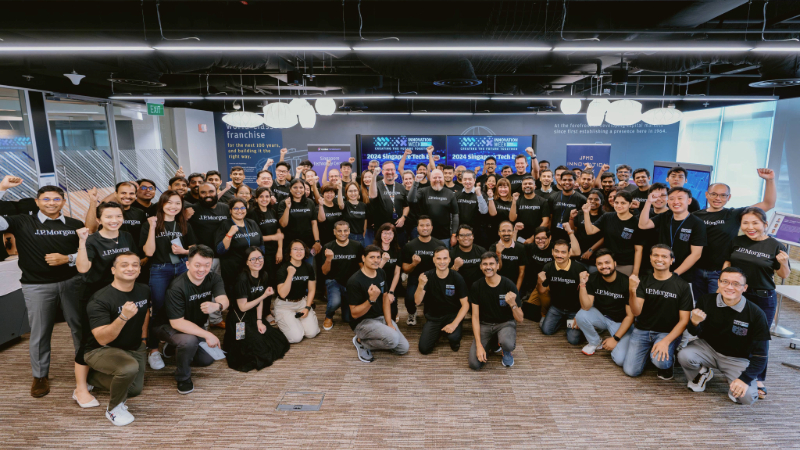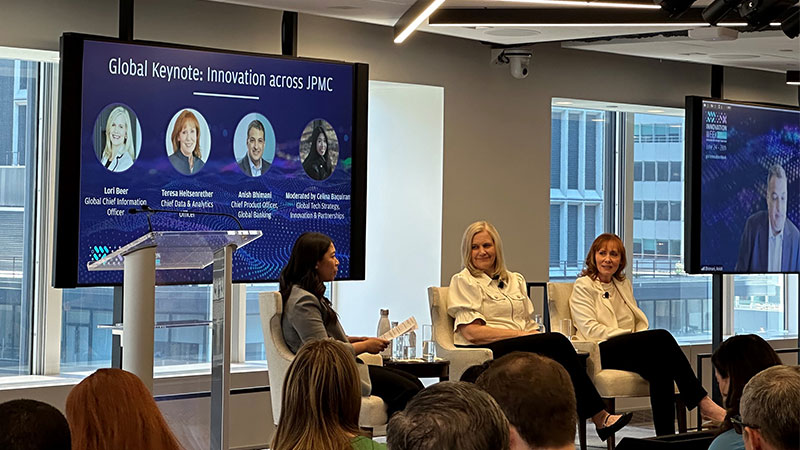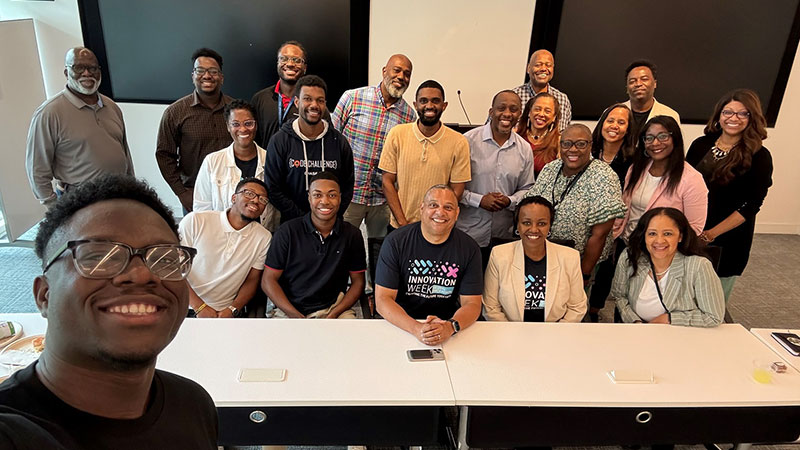Redefining what’s possible with innovation for prosthetic limbs
By Alex Radu, Product Manager, Glasgow
In addition to hearing about innovations across the firm, Innovation Week also brings the opportunity to learn about how other industries are adopting emerging technologies. We had the pleasure of hearing how Open Bionics, a provider of prosthetic limbs, is using innovative technology.
The Innovation Week Opening Keynote in Glasgow transposed us into a world where cutting-edge prosthetics meet superhero-inspired designs. Our journey was stewarded by Samantha Payne MBE, the Co-founder of Open Bionics.
The session started with showcasing the reality of prosthetic limbs from years ago (especially for children), the idea and impact that Open Bionics is creating with their innovative prosthetics and forays in pushing what’s possible with their designs, hardware and open-source efforts. The technology, research and development behind their products is impressive as is the speed with which they built their company and new products in the past 10 years. However, their journey is more than just tech; it's about empowering people, building with the customer in mind and changing perceptions around bionic limbs.
Open Bionics started with a simple dream: create affordable, powerful prosthetics that put the user in control. Its state-of-the-art bionic limbs are a marvel of modern engineering – lightweight, intuitive, and packed with features that help wearers reclaim their independence and superpowers.
The journey started with creating science fiction designs for children. The plates are magnetic so they can choose cool "skins" inspired by science fiction characters, while adults can go for more sleek designs, inspired by video game characters to boost their style points. The dexterity and range of skills that they can achieve with these new designs is far superior when compared to other prosthetics, from picking up marbles, doing makeup, throwing balls and more – their products looked like they were plucked from science fiction themselves. However, Open Bionics didn’t stop there, open sourcing and documenting a lot of their designs, processes and medically-certifying the materials needed to 3D print components, so other researchers and manufacturers around the world, in markets they don’t operate in, can give the same experience and freedom to their patients.
Payne shared with us that their clinics are hubs of creativity, user-centricity, and innovation. They bring together engineers, medical professionals, designers, researchers, and patients to exchange ideas, improve experiences and celebrate achievements that were beyond imagination a few years ago. It's a space where limb difference is seen as a strength, and where limitations turn into superpowers.
Unpacking Generative AI’s promises and possibilities
Kriti Dwivedi, Software Engineer, Hong Kong
It’s commonly acknowledged that Artificial Intelligence (AI) usage has increased significantly as more prominent AI models become available to the public. The speed of adoption for GPT has been much faster than other technologies that we use in our day-to-day lives. Currently, AI has far reaching capabilities and extends beyond the normal use cases, a good stepping point to automate and increase performance of certain tasks. Unlocking the power of AI can lead to a series of possibilities, and while it answers many questions, it no raises some as well.
In an Innovation Week session titled, ‘Can Generative AI Deliver on Its Promise?’ AI experts and enthusiasts sat down to share their perspectives on these topics, breaking down AI’s nuances and agreed upon importance.
Of course, there are concerns around AI that experts and regulators are closely monitoring. For instance, AI models may hallucinate and may have biases based on the training model. The other bigger concerns include data privacy, data quality, regulatory compliance and data availability.
I personally enjoyed learning about the concept of flow engineering, where various capabilities of different AI/ML models are combined to create an optimal result. For example, some AI models are better suited for mathematical analytics and others better suited for creating fast coding solutions, which can be combined to create a dynamic mathematical coding platform quickly. Emergent abilities are another set of AI capabilities where AI can process more complex information including images, mathematics, and science. I also learned that there are several models, both open and closed, that are being developed in the industry for this specific purpose.
This leaves organizations with the question of how AI should be effectively implemented and by whom. As experts continue exploring new iterations of this technology, they have to keep in mind that responsible AI requires continuous oversight and change management. With all of these factors taken into close consideration, Generative AI can drive positive transformation for society.
Bringing blueprints to life
By Rhea Gupta, Software Engineer, Hong Kong
As we conclude this year’s Innovation Week at our Hong Kong tech center, I had the opportunity to attend a session on ‘Mixed Reality and the role of Immersive Tech.’
The session was led by Jason Severn, Asset Wealth Management, Head of Asia Infrastructure, who has worked extensively on exploring these technologies personally and professionally. He began by giving us a comprehensive overview of virtual reality (VR), mixed reality (MR) and extended reality (XR), explaining that they merge the physical and virtual worlds to create new environments where physical and digital objects co-exist and interact in real-time.
One of the most compelling points Jason highlighted was about the potential of VR in revolutionizing architecture and real estate solutions. He was joined by Paul Harris from the Asset Management Real Estate team, who discussed how J.P. Morgan is a pioneer in creating architecture models virtually to showcase properties to potential clients and large corporate occupiers. Imagine a potential buyer being able to walk through a property virtually, being able to visualize and interact with the design and getting a more accurate sense of space and layout than traditional blueprints or static images. This immersive experience allows buyers to have a deeper level of understanding of our offerings, significantly broadening the market and expediting the decision-making process.
While there might be some initial hesitation from the user to put on a headset and experience a building, Paul discussed how in his experience, the enthusiasm of trying a new technology eventually takes over. Corporate occupiers can now visualize and experience how our buildings can become theirs and see their businesses operate in these buildings.
Bringing this technology to our business is truly transformative as it not only emphasizes continued collaboration between technologists and financial experts but also sparks excitement for what lies ahead in our technological journey.
Intelligent Automation transforming processes at JPMorganChase
By Tyler Thomas, Program Analyst, Plano
JPMorganChase has been at the forefront of utilizing Intelligent Automation (IA) to transform our business. IA streamlines manual processes, enhances efficiency and fosters innovation across the organization.
Intelligent Automation encompasses a set of mature tools and capabilities that have modernized and transformed the firm. Some of these tools include robotic process automation (RPA), process modeling and data transformation. Many IA tools now feature embedded AI solutions, enabling the firm to automate time-consuming and mundane tasks. IA solutions have helped the firm respond to complex situations quickly and seamlessly. The efficiencies produced by IA solutions have allowed employees to enrich and transform processes.
IA's no-code and low-code solutions have empowered non-technical staff to innovate and transform their work. The adoption of IA solutions has fostered a culture of continuous improvement and innovation within the firm.
IA solutions have directly laid the foundation for AI solutions within the firm. These new solutions will empower us to offer impactful insights for our clients, enhancing the client experience and unlocking new connected experiences.
JPMorganChase is well-positioned in the 'new AI age' to adopt new processes and tools to better support our employees and clients with their goals. By staying at the cutting edge of technology, we can continue to serve our clients effectively and maintain our competitive edge in the market.
The latest on emerging tech trends
By Aditi Singh, Software Engineer, Hong Kong
The Emerging Technology Trends seminar during Innovation Week, led by the Global Tech Strategy, Innovation, and Partnerships team, provided a comprehensive view of the transformative forces reshaping industries today. The session underscored our firm’s strategic approach to identifying and leveraging emerging technologies, offering key insights into their collaborative innovation framework and the technological inflection points driving their business strategies.
Central to our strategy is a collaborative effort involving product teams and external partners. This ecosystem enables innovation within the context of our lines of business, strategic investments revenue generation and overall economic growth. This approach allows for JPMorganChase to remain at the forefront of technological advancement, continually adapting to meet evolving market demands.
The session also highlighted several pivotal technological advancements that have shaped the innovation journey in recent years. Starting with infrastructure and abstraction, innovations such as containerization in 2015 have revolutionized how businesses manage and deploy applications. Moreover, the shift towards data modernization and adoption of public cloud solutions underscores JPMorganChase's commitment to scalable, efficient data management practices.
JPMorganChase emphasized the transformational impact of Generative AI and automation in streamlining processes, reducing manual labor, and enhancing scalability. This includes advancements in AI-driven data analytics and management tools, simplifying access to and utilization of complex datasets across hybrid multi-cloud environments.
From enhancing content collaboration and personalized content delivery, to improving user experience through AI-driven design and virtual assistants, Generative AI is reshaping industry norms and driving operational efficiencies.
Moreover, the seminar emphasized the importance of addressing security challenges in AI deployment. Measures such as model security testing, AI proxy/guardrails, and robust data security frameworks should be in place to mitigate risks associated with AI-driven technologies.
In conclusion, our firm’s perspective on emerging technology trends underscores our commitment to innovation, strategic partnerships and leveraging cutting-edge technologies to drive business growth and meet evolving client needs in a rapidly changing digital landscape.
To read more about the latest technology trends, latest technology trends, click here.







